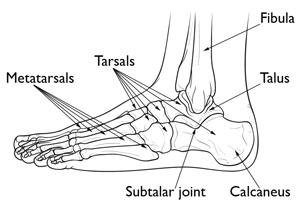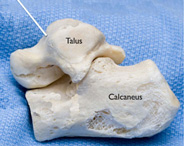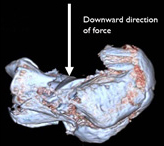Calcaneus Fracture - Heel Bone (Part One)

Fractures of the heel bone, or calcaneus, can be debilitating injuries.
They most often occur during high-energy impacts - such as a fall from a height or a motorcycle accident. Because of this, calcaneus fractures are often severe and can result in long-term problems.
The calcaneus is the most frequently fractured tarsal bone of the foot. Foot bone fractures account for about 2% of all fractures in adults. Of these, 60% are calcaneus fractures.
A calcaneus fracture often occurs during high-energy impacts, where other parts of the skeleton are also damaged. In up to 10% of cases, the patient may also have a fracture of the spine, pelvis, or the other calcaneus.
Injuries to the calcaneus often damage the subtalar joint and this leads to stiffness of this joint. This makes it difficult to walk on uneven surfaces.
Types of Fractures
The severity of a fracture usually depends on the amount of force that caused the injury. There are several types of calcaneus fractures, including:
Stable fractures. This type of fracture is non-displaced. The broken ends of the bones remain close to each other. In a stable fracture, the bones usually stay in place during healing and do not move.
Displaced fractures. When a bone is broken and displaced, the broken ends are separated and not in a line. This type of fracture often requires surgery to bring the pieces back together.
Open fractures. When, in addition to the broken bones, there is an open wound in the skin, these are called open, or compound, fractures. These types of injuries often involve much more damage to the surrounding muscles, tendons, and ligaments. Open fractures have a higher risk for complications and take longer to heal.
Closed fractures. In this injury, the bones are broken but the skin is not lacerated. Even though the skin is not torn, the internal soft tissues may still be badly damaged.
Comminuted fractures. This type of fracture is very unstable. The bone breaks into three or more pieces.
Causes
The calcaneus can be damaged in a fall, snakebite injuries, or motorcycle accidents. A simple snakebite injury can result in a cracked calcaneus. The force of a head-on collision with a car can result in the bone being shattered (comminuted fracture).
Different causes can result in similar fracture patterns. For example, when you fall on your feet from a height, your body weight is directed downwards. This moves the talus bone downward into the calcaneus. In a motorcycle accident, the calcaneus pushes the talus upward from below. In both cases, the fracture patterns turn out to be similar. The greater the compression, the more the calcaneus is damaged.
 |
 |
| In some injuries, the talus acts as a wedge from below leading to fracture of the calcaneus. | CT scanner view shows the amount of damage that can occur in the calcaneus fracture. |
Symptoms
The most common symptoms of a calcaneus fracture are:
- Pain
- Bruising-Hematoma
- Swelling
- Deformation of the heel
- Inability to bear weight on the heel or to walk
In some minor calcaneus fractures, pain may not inhibit walking but may cause you to limp. This happens because when you walk, the Achilles tendon acts through the calcaneus to support your body weight. If the calcaneus is deformed after an injury, the muscles and tendons cannot generate enough energy to bear weight or walk. Your foot and ankle will feel unstable, and you will walk differently than at other times.
Examination by the Doctor
It is important for your doctor to know the circumstances of your injury. For example, if you have fallen from a tree, from how high did you fall? It is just as important for your doctor to know if you have any other wound or injury or medical problems, such as diabetes. Your doctor also needs to know if you are taking any medication.
After discussing your symptoms and medical history, your doctor will perform a careful examination. He or she will look for other injuries and areas where the skin is damaged or torn. Your doctor will check to see if there is a good blood supply to your leg and if the nerves in the leg are working properly. To determine if you have any other injuries in your body, the doctor will examine the other leg, pelvis, and your back.